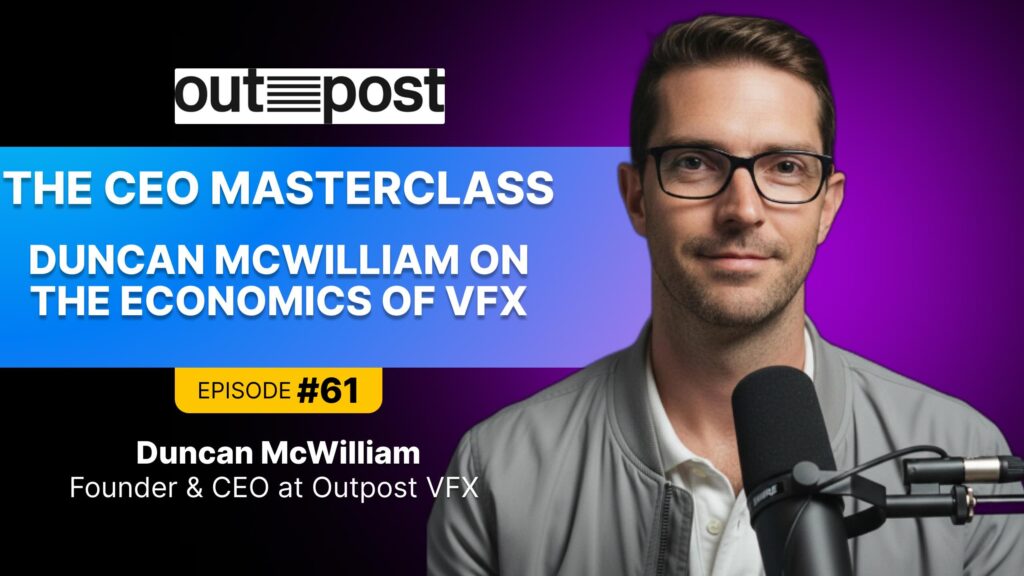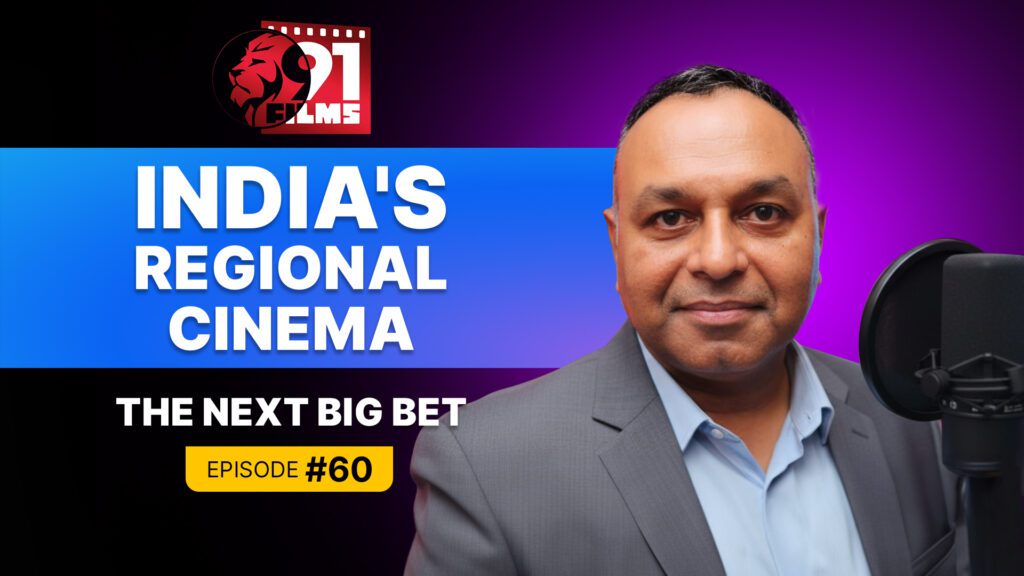In this podcast, we dive into the world of visual effects with Joseph Bell, a seasoned expert who has navigated the VFX landscape for over two decades. From pioneering roles at (ILM) to scaling startups and analyzing industry trends, Joseph offers his views on the current VFX trends and unparalleled insights into the evolving dynamics and future of visual effects. Welcome, Joseph!
In 2024, the industry’s recovery is slower than expected, largely due to streaming services holding back on content spending. Once Disney and others reach profitability, I anticipate a surge in demand for new content, including VFX, despite some planned reductions in major franchises like Marvel.
Podcast Chapters
| Time | Topic |
| 00:00 | Introduction and Background |
| 04:22 | The Impact of COVID-19 and the Content Arms Race |
| 08:13 | The Effects of COVID-19 and the Hollywood Strikes |
| 13:31 | The Changing Business Model of Visual Effects Companies |
| 24:59:00 | Trends in the Industry: A Look at the Data |
| 30:20:00 | The Impact of Technology on the VFX Industry |
| 38:54:00 | Outlook for the Industry and Key Focus Areas |
Consolidation in the VFX industry has resulted in eight of the top ten groups now operating multiple studios under one umbrella, representing around 35% of the industry. This consolidation, largely from 2010 to 2018, allows these conglomerates greater flexibility to leverage global tax incentives and labor pools.
Key VFX Trend Takeaways:
- The VFX industry experienced a peak in demand in 2022, driven by the content arms race among streaming services and the surge in spending on television and streaming content.
- The COVID-19 pandemic and the Hollywood strikes have had a significant impact on the industry, leading to a slowdown in production and a reduction in the number of visual effects and animation jobs.
- Consolidation is a growing trend in the industry, with larger companies acquiring smaller studios to tap into tax incentives and access different labor pools.
- The business model of visual effects companies is evolving, with a focus on client service and the ability to deliver high-quality work on time.
- Technological advancements, such as cloud-based workflows, generative AI, gaming engines, and virtual production, are shaping the future of the industry.
Sound Bites:
- “The spending was at a rate that turned out to not be sustainable in the long run.”
- “Disney decreased their content commissions by 47% last year.”
- “Television has a fast turnaround and the satisfaction of getting something up on the screen in front of an audience.”
About Joseph Bell:
Navigating the VFX Landscape: A Conversation with Joseph Bell
Introduction:
This is a written version of the podcast featuring Joseph Bell, hosted by Atul from Vitrina. Summarized for quick reading, this transcript-style Q&A explores the evolving VFX landscape — from demand spikes and industry corrections to emerging technologies and consolidation trends.
- Vitrina: Can you tell us about your background in the VFX industry and how your career has evolved over time?
Joseph Bell:
“I’ve been in the visual effects industry for 20 years at this point, and I’m very much a practitioner. I started out in production roles as a VFX producer, production manager, and I worked at a variety of smaller companies in Los Angeles at the start of my career before going up to San Francisco to join Industrial Light and Magic, Lucasfilm, which I’m sure you’re all familiar with. After three years at ILM, I joined a startup in Los Angeles. I was in the garage with the founders of a company called Cosa VFX, which we scaled from the five of us in the garage to about 180 people over the next few years.
Having seen a number of different companies operating in the industry and having friends all over the place, I became interested in understanding more the context of the VFX industry… So I went back to school a few years ago and snagged myself an MBA… That gave me wonderful exposure to other industries like airlines and technology and automotive… Since then, I’ve worked in a variety of executive roles. I do a bit of consulting. I work with investors and folks engaged with mergers and acquisitions in the VFX industry.”
- Vitrina: You describe yourself as a “practitioner” — what does that mean in your context?
Joseph Bell:
“I’ve had the privilege to be in roles that were to do with sort of production management and studio leadership that let me work very closely with creatives, with artists on the factory floor. So, you know, I have fond memories of standing at an artist desk at two in the morning saying, ‘I’m sorry, the director gave us more notes and he’s gonna be here at 9 a.m., so I’m gonna stay with you.’ You know, and just in the heat of production… I’ve sat in dailies. I’ve sat next to Oscar-winning visual effects supervisors working with large teams of creative artists. Personally, I have, I think, something like 70 film and television credits, two Emmy nominations from actually having been on the factory floor doing the work.”
- Vitrina: What were the most dramatic changes the VFX industry experienced in the last four years?
Joseph Bell:
“It’s been a roller coaster for the industry… 2022 was the highest demand ever for visual effects… driven in large part by the major Hollywood studios and other big-spending, big-budget entertainment and media clients. The vast majority of jobs… are tied to a relatively small number of big clients. There was a content arms race between the streamers trying to attract eyeballs… but the spending was at a rate that has turned out to not be sustainable in the long run.
Too much TV… superhero fatigue… we reached the point where there weren’t enough visual effects artists, probably in the world… it became an employee’s market. Rates and costs were less of a concern… Some client-side studios purchased visual effects companies — Netflix acquired Scanline, Sony got Pixelmondo — but they still take on work for other clients… really just a hedge against running out of capacity.
COVID also kept us all at home watching TV and playing video games… 2023 brought a dramatic correction… 368 fewer scripted series were commissioned globally… a 36% drop in overall production volume… In Quebec, the number of VFX and animation jobs dropped 43%. That’s more than the 27% drop during COVID. And it’s a larger percentage of a larger base. The impact is pretty significant.”
- Vitrina: How did the Hollywood and UK strikes influence this downturn?
Joseph Bell:
“The strikes played a role, but I think they actually distracted a lot of people from the real drivers. Production halted during the strikes, but the knock-on effect for VFX and animation comes later… the real slowdown was already happening — a drop in project commissioning by streamers who are now striving for profitability.
Disney, for example, saw a 70% drop in new subscribers in 2023 versus 2022… they decreased their content commissions by 47%. That’s massive. Amazon’s Rings of Power cost $465 million plus $250 million for the rights. So you’re talking about needing over five million new subscribers to break even.”
- Vitrina: How does VFX work differ between television and film?
Joseph Bell:
“When we talk about television these days, the operating practices of the streamers come to mind… Back in the day, advertiser-driven broadcast television meant seasons could be cancelled halfway through. But the turnaround was fast, and there was the satisfaction of getting something in front of audiences. A 22-episode season used to play out over a year — comparable to a feature film in schedule.
Feature films tend to have more predictable schedules — you know the script up front. In TV, you might discover the budget is going up mid-season. There’s less predictability.”
- Vitrina: How do you see the VFX business model today, and what are its core pressure points?
Joseph Bell:
“I’m notorious in my little corner of VFX for having a strong opinion about the business model… This is a creative services business. Even if Scanline is owned by Netflix, there’s still a client-vendor relationship. If your clients aren’t happy, it doesn’t matter how good it looks — if it’s late, that’s what they’ll remember.
The barriers to entry have lowered with better technology… a five-person VFX studio today can rival ILM of the early 1990s. But for massive projects — a thousand shots and 60 characters — you need scale. The challenge is delivering great client service while adapting to client size and expectations.”
- Vitrina: Is the VFX industry entering a phase of consolidation?
Joseph Bell:
“Yes. Right now in 2024, the recovery is slower than expected. Streamers need to loosen their purse strings. I believe Disney+ is already or nearly profitable — others will follow soon. Once they cross that threshold, they’ll see audiences hungry for content and there’ll be a surge in demand.
That said, Bob Iger talked about halving Marvel’s output… that alone could remove about 3% of global VFX spend. The top 10 VFX players — 8 of them are part of groups with multiple studios under one umbrella… 35% of the industry. Most of this consolidation happened between 2010 and 2018.”
- Vitrina: What drives consolidation strategies in VFX groups?
Joseph Bell:
“The driver is almost always tax incentives… and labor costs. Owning multiple brands lets groups tap into incentives globally and access diverse labor pools.
You see two M&A strategies: a ‘house of brands’ like Cinesite, where each brand keeps its identity and pipelines. Then you have integrated models like Framestore, which brought Method Studios into its pipeline. Like car factories — you can’t use the same pipeline for BMWs and Kias. Framestore has highly tuned ‘factories’ for different types of work.”
- Vitrina: What was the intent behind the industry chart you shared on LinkedIn?
Joseph Bell:
“It was meant to show trends — not precise headcount or profitability. From June 2022 to June 2024, the left side shows growth during the 2022 boom. The right side shows the last six months — more companies in red (shrinking), fewer in blue (growing). Smaller companies show more dramatic percentages.
It’s based on LinkedIn data, which includes freelancers… many firms show 167 employees officially but may have 350 working via contracts. The chart’s an indicator, not a full financial picture, but it resonated — over 21,000 views and a lot of feedback.”
- Vitrina: How are buyers and investors looking at the VFX landscape now?
Joseph Bell:
“Buyers want the right partner for the right project… some companies said, ‘we laid off 60% of our staff,’ others said, ‘that chart is spot on.’ The trends are broadly accurate — it’s a bellwether. Everyone’s watching for signals of recovery — and the bigger platforms like Netflix, Amazon, and Sony are already showing signs of ramping up again.”
- Vitrina: Which technologies have made the biggest impact in the last four years?
Joseph Bell:
“Camera-to-cloud workflows — definitely accelerated by COVID. It’s real now. Virtual production has grown steadily. Game engines are changing how we think about previsualization and production workflows. Generative AI — it’s early days. It hasn’t fully landed, but it’s coming. Each of these affects collaboration, budget, and scheduling in different ways.”
- Vitrina:s What’s your outlook for the rest of 2024 and heading into 2025?
Joseph Bell:
“I fully expect that once streamers hit profitability and realize their audiences are starved for new content, there will be a surge in demand… VFX will come back. Not exactly like 2022, but with recovery. Jobs may move around. Consolidation may continue. But by 2025, we’ll likely see renewed growth, especially from the bigger content buyers making up for lost time.”








